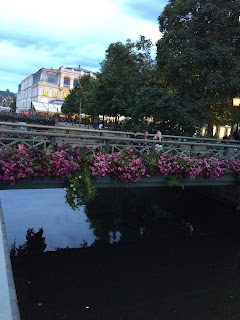Today we played tourist, purchasing a 24-hour City One card @ SEK 350 each (approximately $50 USD each - no senior discount!). We got our kroners' worth too! We rode the tourist train. We rode the tourist bus. We took the tourist boat ride through the canals and out into the harbor! We also experienced a lot of different weather! We still can ride any and all public transportation for free until our train departs tomorrow for Stockholm.
 Göteborg (pronounced /Yō tuh BOee/) is the second largest city in Sweden and has a population of 550,000 (900,000 +/- if you include the suburbs). It is halfway between the Norwegian capital of Oslo and the Danish capital of Copenhagen.
Göteborg (pronounced /Yō tuh BOee/) is the second largest city in Sweden and has a population of 550,000 (900,000 +/- if you include the suburbs). It is halfway between the Norwegian capital of Oslo and the Danish capital of Copenhagen. Göteborg was founded in 1621 on the Göte River. Dutch engineers were hired to figure out how to build a city on swampy land. Because of threats from the Danes and Norwegians, the original city was built rather like a fortress, surrounded by a 7-meter high wall and a moat that is a canal system. This moat/canal system served as both water cachement and sewage... Needless to say, cholera epidemics were regular and rampant before that was figured out!
Because of the high water table and swampy land, a subway system is not possible. Therefore, Göteborg has lots and lots and lots of trams and busses! The tram system, with over 80 km (50 miles) of double track, has been in place for more than 100 years.

In the 19th century, the working class lived outside the city walls in the overcrowded ghetto of Haga. Haga is now filled with boutiques and charming restaurants.


 Due to its location (access to both the Atlantic and the North Sea), Göteborg's historical economy has been based on maritime industries such as ship building, shipping and fishing.
Due to its location (access to both the Atlantic and the North Sea), Göteborg's historical economy has been based on maritime industries such as ship building, shipping and fishing.
The fishermen would bring in their daily catch, and their wives would sell outdoors year-round. The women insisted on an indoor fish market. Health authorities agreed, although on behalf of the fish being sold, not necessarily on behalf of the women selling.
Feskeköran was then built in 1874 and is an indoor fish market. Feskekörkan got its name from the building's resemblance to a Gothic church. However, the saying is that the Swedes believe in cod more than they believe in God...
Skanskaskrapan, or more commonly known as "The Lipstick building" is 86 m (282 ft) high with 22 floors. It has the distinction of being named "the ugliest building in Sweden" (perhaps the ugliest building in all of Scandinavia...)
The Saluhallen (Food Hall) was built between the years 1888-1889. Much like the Central Market in downtown Los Angeles, one can purchase meats, candies, breads and baked goods, cheeses, spices, lunches
















Isn't the boat ride wonderful????????
ReplyDelete